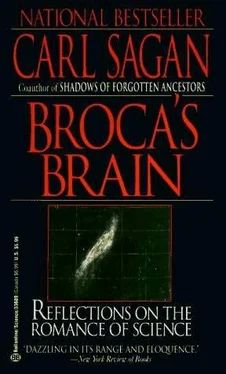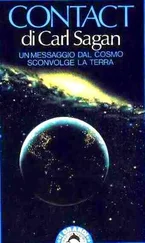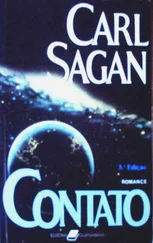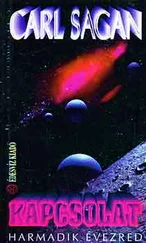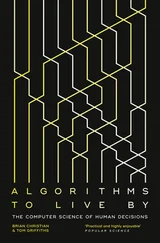Carl Sagan - Broca's Brain - The Romance of Science
Здесь есть возможность читать онлайн «Carl Sagan - Broca's Brain - The Romance of Science» весь текст электронной книги совершенно бесплатно (целиком полную версию без сокращений). В некоторых случаях можно слушать аудио, скачать через торрент в формате fb2 и присутствует краткое содержание. Жанр: Физика, на английском языке. Описание произведения, (предисловие) а так же отзывы посетителей доступны на портале библиотеки ЛибКат.
- Название:Broca's Brain: The Romance of Science
- Автор:
- Жанр:
- Год:неизвестен
- ISBN:нет данных
- Рейтинг книги:3 / 5. Голосов: 1
-
Избранное:Добавить в избранное
- Отзывы:
-
Ваша оценка:
- 60
- 1
- 2
- 3
- 4
- 5
Broca's Brain: The Romance of Science: краткое содержание, описание и аннотация
Предлагаем к чтению аннотацию, описание, краткое содержание или предисловие (зависит от того, что написал сам автор книги «Broca's Brain: The Romance of Science»). Если вы не нашли необходимую информацию о книге — напишите в комментариях, мы постараемся отыскать её.
Broca's Brain: The Romance of Science — читать онлайн бесплатно полную книгу (весь текст) целиком
Ниже представлен текст книги, разбитый по страницам. Система сохранения места последней прочитанной страницы, позволяет с удобством читать онлайн бесплатно книгу «Broca's Brain: The Romance of Science», без необходимости каждый раз заново искать на чём Вы остановились. Поставьте закладку, и сможете в любой момент перейти на страницу, на которой закончили чтение.
Интервал:
Закладка:
Such views or their equivalent are only slowly changing, and it is possible to see some of the roots of racism and nationalism in their pervasive early acceptance by virtually all human communities. But we live in an extraordinary time, when technological advances and cultural relativism have made such ethnocentrism much more difficult to sustain. The view is emerging that we all share a common life raft in a cosmic ocean, that the Earth is, after all, a small place with limited resources, that our technology has now attained such powers that we are able to affect profoundly the environment of our tiny planet. This deprovincialization of mankind has been aided powerfully, I believe, by space exploration-by exquisite photographs of the Earth taken from a great distance, showing a cloudy, blue, spinning ball set like a sapphire in the endless velvet of space; but also by the exploration of other worlds, which have revealed both their similarities and their differences to this home of mankind.
We still talk of “the” world, as if there were no others, just as we talk about “the” Sun and “the” Moon. But there are many others. Every star in the sky is a sun. The rings of Uranus represent millions of previously unsuspected satellites orbiting Uranus, the seventh planet. And, as space vehicles have demonstrated so dramatically in the last decade and a half, there are other worlds-nearby, relatively accessible, profoundly interesting, and not a one closely similar to ours. As these planetary differences, and the Darwinian insight that life elsewhere is likely to be fundamentally different from life here, become more generally perceived, I believe they will provide a cohesive and unifying influence on the human family, which inhabits, for a time, this unprepossessing world among an immensity of others.
Planetary exploration has many virtues. It permits us to refine insights derived from such Earth-bound sciences as meteorology, climatology, geology and biology, to broaden their powers and improve their practical applications here on Earth. It provides cautionary tales on the alternative fates of worlds. It is an aperture to future high technologies important for life here on Earth. It provides an outlet for the traditional human zest for exploration and discovery, our passion to find out, which has been to a very large degree responsible for our success as a species. And it permits us, for the first time in history, to approach with rigor, with a significant chance of finding out the true answers, questions on the origins and destinies of worlds, the beginnings and ends of life, and the possibility of other beings who live in the skies-questions as basic to the human enterprise as thinking is, as natural as breathing.
Interplanetary unmanned spacecraft of the modern generation extend the human presence to bizarre and exotic landscapes far stranger than any in myth or legend. Propelled to escape velocity near the Earth, they adjust their trajectories with small rocket motors and tiny puffs of gas. They power themselves with sunlight and with nuclear energy. Some take only a few days to traverse the lake of space between Earth and Moon; others may take a year to Mars, four years to Saturn, or a decade to traverse the inland sea between us and distant Uranus. They float serenely on pathways predetermined by Newtonian gravitation and rocket technology, their bright metal gleaming, awash in the sunlight which fills the spaces between the worlds. When they arrive at their destinations, some will fly by, garnering a brief glimpse of an alien planet, perhaps with a retinue of moons, before continuing on farther into the depths of space. Others insert themselves into orbit about another world to examine it at close range, perhaps for years, before some essential component runs down or wears out. Some spacecraft will make landfall on another world, decelerating by atmospheric friction or parachute drag or the precision firing of retrorockets before gently setting down somewhere else. Some landers are stationary, condemned to examine a single spot on a world awaiting exploration. Others are self-propelled, slowly wandering to a distant horizon which holds no man knows what. And still others are capable of remotely acquiring rock and soil-a sample of another world-and returning it to the Earth.
All these spacecraft have sensors that extend astonishingly the range of human perception. There are devices that can determine the distribution of radioactivity over another planet from orbit; that can feel from the surface the faint rumble of a distant planetquake deep below; that can obtain three-dimensional color or infrared images of a landscape like none ever seen on Earth. These machines are, at least to a limited degree, intelligent. They can make choices on the basis of information they themselves receive. They can remember with great accuracy a detailed set of instructions which, if written out in English, would fill a good-sized book. They are obedient and can be reinstructed by radio messages sent to them from human controllers on Earth. And they have returned, mostly by radio, a rich and varied harvest of information on the nature of the solar system we inhabit. There have been fly-bys, crash-landers, soft-landers, orbiters, automated roving vehicles, and unmanned returned sample missions from our nearest celestial neighbor, the Moon-as well as, of course, six successful and heroic manned expeditions in the Apollo series. There has been a fly-by of Mercury; orbiters, entry probes and landers on Venus; fly-bys, orbiters and landers to Mars; and fly-bys of Jupiter and Saturn. Phobos and Deimos, the two small moons of Mars, have been examined close up, and tantalizing images have been obtained of a few of the moons of Jupiter.
We have caught our first glimpses of the ammonia clouds and great storm systems of Jupiter; the cold, salt-covered surface of its moon, Io; the desolate, crater-pocked, ancient and broiling Mercurian wasteland; and the wild and eerie landscape of our nearest planetary neighbor, Venus, where the clouds are composed of an acid rain that falls continuously but never patters the surface because that hilly landscape, illuminated by sunlight diffusing through the perpetual cloud layer, is everywhere at 900°F. And Mars: What a puzzle, what a joy, enigma and delight is Mars, with ancient river bottoms; immense, sculpted polar terraces; a volcano almost 80,000 feet high; raging windstorms; balmy afternoons; and an apparent initial defeat of our first pioneering effort to answer the question of questions-whether the planet harbors, now or ever, a home-grown form of life.
There are on Earth only two spacefaring nations, only two powers so far able to send machines much beyond the Earth’s atmosphere-the United States and the Soviet Union. The United States has accomplished the only manned missions to another body, the only successful Mars landers and the only expeditions to Mercury, Jupiter and Saturn. The Soviet Union has pioneered the automated exploration of the Moon, including the only unmanned rovers and return sample missions on any celestial objects, and the first entry probes and landers on Venus. Since the end of the Apollo program, Venus and the Moon have become, to a certain degree, Russian turf, and the rest of the solar system visited only by American space vehicles. While there is a certain degree of scientific cooperation between the two spacefaring nations, this planetary territoriality has come about by default rather than by agreement. There have in recent years been a set of very ambitious but unsuccessful Soviet missions to Mars, and the United States launched a modest but successful set of Venus orbiters and entry probes in 1978. The solar system is very large and there is much to explore. Even tiny Mars has a surface area comparable to the land area of the Earth. For practical reasons it is much easier to organize separate but coordinated missions launched by two or more nations than cooperative multinational ventures. In the sixteenth and seventeenth centuries, England, France, Spain, Portugal and Holland each organized on a grand scale missions of global exploration and discovery in vigorous competition. But the economic and religious motives of exploratory competition then do not seem to have their counterparts today. And there is every reason to think that national competition in the exploration of the planets will, at least for the foreseeable future, be peaceful.
Читать дальшеИнтервал:
Закладка:
Похожие книги на «Broca's Brain: The Romance of Science»
Представляем Вашему вниманию похожие книги на «Broca's Brain: The Romance of Science» списком для выбора. Мы отобрали схожую по названию и смыслу литературу в надежде предоставить читателям больше вариантов отыскать новые, интересные, ещё непрочитанные произведения.
Обсуждение, отзывы о книге «Broca's Brain: The Romance of Science» и просто собственные мнения читателей. Оставьте ваши комментарии, напишите, что Вы думаете о произведении, его смысле или главных героях. Укажите что конкретно понравилось, а что нет, и почему Вы так считаете.
